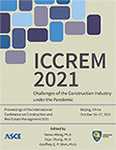Research on the Carbon Footprint of Steel Structure during Materialization Stage Based on BIM
Publication: ICCREM 2021
ABSTRACT
The lightweight and recyclable characteristics of steel structure can greatly reduce environmental damage. However, there are limited research studies examining the carbon footprint of steel structure with advanced technology, for example, building information modeling (BIM). BIM provides a cloud platform to perform data interaction and various simulations at the beginning of project. This paper aims to develop a BIM-based method to evaluate the potential of carbon footprint reduction during the materialization stage of steel structure (compared with concrete-steel structure). Taking two public buildings in Beijing as examples for this study, the carbon footprints of different materials were calculated. This study provides a systematic and efficient BIM approach to measure the carbon footprint of new buildings and the reduction potential of steel structure. It provides valuable assets for helping governments, constructors, and designers to achieve sustainable construction.
Get full access to this article
View all available purchase options and get full access to this chapter.
REFERENCES
Chau, C., Hui, W., Ng, W., and Powell, G. (2012). “Assessment of CO2 emissions reduction in high-rise concrete office buildings using different material use options.” Resources, Conservation and Recycling, 61, 22–34.
Chau, C., Leung, T., and Ng, W. (2015). “A review on life cycle assessment, life cycle energy assessment and life cycle carbon emissions assessment on buildings.” Applied Energy, 143(1), 395–413.
Chau, C., Xu, J., Leung, T., and Ng, W. (2017). “Evaluation of the impacts of end-of-life management strategies for deconstruction of a high-rise concrete framed office building.” Applied Energy, 185, 1595–1603.
Chen, X., Shuai, C., Wu, Y., and Zhang, Y. (2020). “Analysis on the carbon emission peaks of China’s industrial, building, transport, and agricultural sectors.” Science of the Total Environment, 709, 135768.
Cubi, E., Doluweera, G., and Bergerson, J. (2015). “Incorporation of electricity GHG emissions intensity variability into building environmental assessment.” Applied Energy, 159(1), 62–69.
De Wolf, C., Pomponi, F., and Moncaster, A. (2017). “Measuring embodied carbon dioxide equivalent of buildings: a review and critique of current industry practice.” Energy and Buildings, 140, 68–80.
Hao, J., Cheng, B., Lu, W., Xu, J., Wang, J., Bu, W., and Guo, Z. (2020). “Carbon emission reduction in prefabrication construction during materialization stage: a BIM-based life-cycle assessment approach.” Science of the Total Environment, 723, 137870.
Li, X., Lai, J., Ma, C., and Wang, C. (2021). “Using BIM to research carbon footprint during the materialization phase of prefabricated concrete buildings: a China study.” Journal of Cleaner Production, 279(8), 123454.
Luo, L., and Chen, Y. (2020). “Carbon emission energy management analysis of LCA-Based fabricated building construction.” Sustainable Computing: Informatics and Systems, 27, 100405.
Luo, W., Ma, X., Meng, C., Xu, L., Tsou, J., Yang, S., and Mao, Z. (2020). “Carbon emission modeling and analysis of building materialization process.” IOP Conference Series: Earth and Environmental Science, 531(1), 012049.
Peng, C. (2016). “Calculation of a building’s life cycle carbon emissions based on ecotect and building information modeling.” Journal of Cleaner Production, 112, 453–465.
Qiao, C., Hu, P., Pan, Q., and Geng, J. (2019). “Research on CO2 emission reduction of a steel structure prefabricated building considering resource recovery.” IOP Conference Series: Earth and Environmental Science, 237(2), 22036–22036.
Yang, X., Hu, M., Wu, J., and Zhao, B. (2018). “Building-information-modeling enabled life cycle assessment, a case study on carbon footprint accounting for a residential building in China.” Journal of Cleaner Production, 183, 729–743.
Zhang, Y., Zheng, X., Zhang, H., Chen, G., and Wang, X. (2014). “Carbon emission analysis of a residential building in China through life cycle assessment.” Frontiers of Environmental Science & Engineering, 10(1), 150–158.
Information & Authors
Information
Published In
Copyright
© 2021 American Society of Civil Engineers.
History
Published online: Dec 9, 2021
Authors
Metrics & Citations
Metrics
Citations
Download citation
If you have the appropriate software installed, you can download article citation data to the citation manager of your choice. Simply select your manager software from the list below and click Download.
